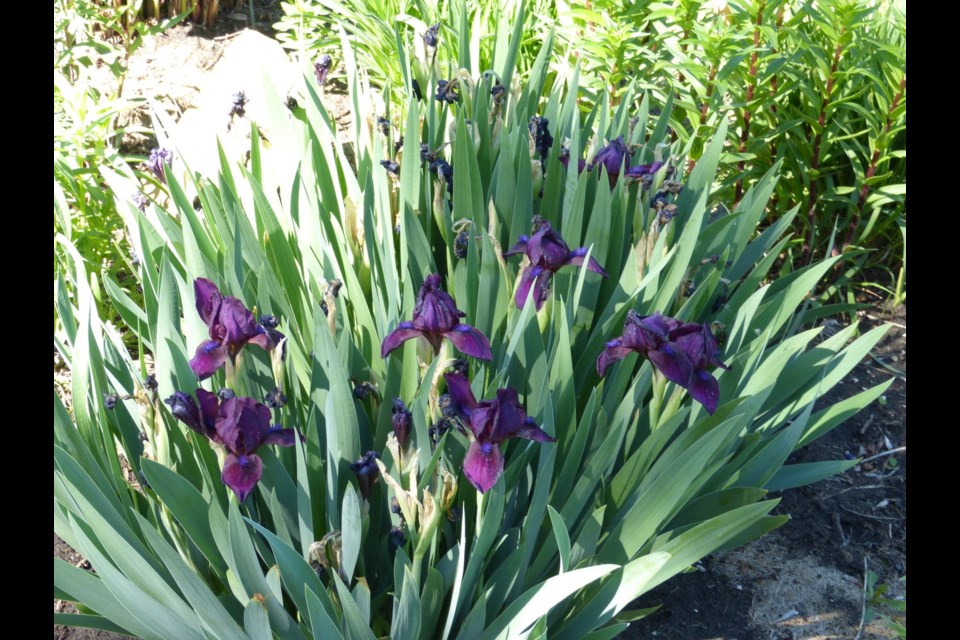Of the 200 species in the genus Iris, only a few flourish in our northern gardens. Iris have been classified in many ways over the last few centuries and the nomenclature and origin of some species remains confused.
Both the genus and the common name honour the mythological Greek messenger, Iris, who came to Earth via a rainbow and left these flowers, in a rainbow of colours, wherever she wandered. Iris have been cultivated since 1500 BCE and have become widely naturalized in many regions. Much of their origin is shrouded in mystery. A great deal of the information on the parentage of what we now call "species" (but are more likely natural hybrids) is said to be pure speculation.
The most dependable and widely grown species on the Canadian prairies are the bearded iris (Iris germanica), the Siberian iris (Iris sibirica) and the blue flag iris (Iris versicolor).
Of these, the bearded iris is the most commonly grown. There are thousands of cultivars. A recent estimate is over 20,000! The word "bearded" refers to a prominent patch of brightly coloured hairs found on the falls or lower tepals. Why the common name German bearded iris? Another mystery! They are not native to Germany nor has a lot of breeding been carried out in that country. It is now generally accepted that this is not a true species, but ancient hybrids of unknown parentage. It has become an umbrella term for a large group native to the Mediterranean region and naturalized in many countries. A heritage variety that has been grown in Prairie gardens since before the First World War is the blue and white 'Mrs Andrist'.
Description
Iris germanica forms an erect clump of linear, sword-shaped leaves, often held in a fan and varying in height from 15 to 90 cm (6-36 in.). The flowers, in all colours of the rainbow, consist of three outer tepals (the "falls") and three smaller upright inner petals (the "standards") and appear in late spring and early summer. The roots consist of thick rhizomes, which practically exclude weeds, and are usually visible on the soil surface.
Iris should be planted in well-drained soil, with a pH at or above neutral, in full sun. The rhizomes should be on or level with the soil. They are drought tolerant once established. Divide them every 3 or 4 years or the clumps will eventually die out in the centre due to overcrowding.
Classification based on height and hardiness:
Miniature Dwarf iris (Iris pumila) are 15 to 20 cm (6-8 in.) in height and are dependably hardy in zones 3b to 2.
Standard Dwarf iris are 20 to 40 cm (8-15 in.) in height and dependably hardy in zones 3b to 2.
Border or Intermediate iris are 40 to 70 cm (15-28 in.) in height and dependably hardy in zones 3b to 2.
Tall bearded iris is 70 cm (28 in.) in height or over. This group is NOT dependably hardy in zones 3b to 2, although they are always available for sale.
Intermediate bearded iris make a fine addition to the mid-section of a perennial border while the dwarf varieties are at home at the front of a border or in a rock garden. All are quite drought-tolerant once established and also do well in a xeriscape setting once established. Iris are easily increased by rhizome division (each with a fan of leaves and roots) after flowering.
Next week’s article will describe the numerous varieties of iris which are generally available to prairie gardeners through nurseries, greenhouses and catalogues.
Sara Williams is the author of many books including Gardening Naturally with Hugh Skinner, Creating the Prairie Xeriscape, and with Bob Bors, Growing Fruit in Northern Gardens. She gives workshops on a wide range of gardening topics throughout the prairies.
This column is provided courtesy of the Saskatchewan Perennial Society (SPS; [email protected]). Check our website (www.saskperennial.ca) or Facebook page (www.facebook.com/saskperennial) for a list of upcoming gardening events.




